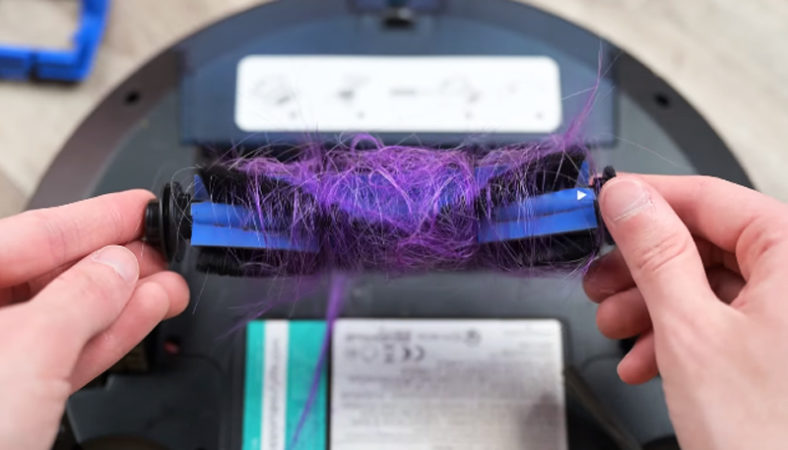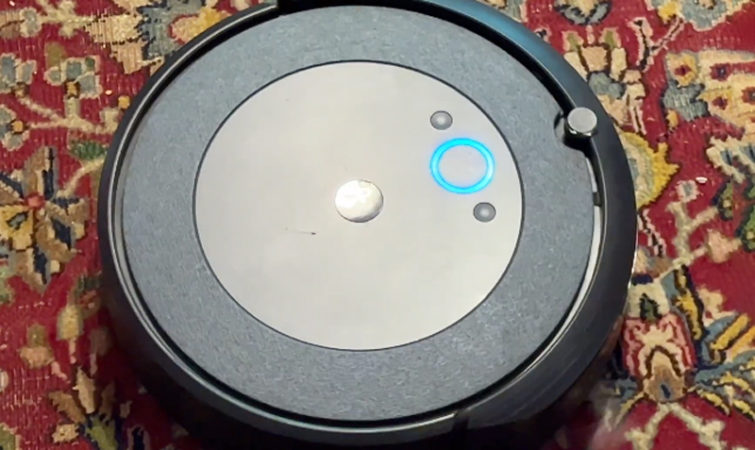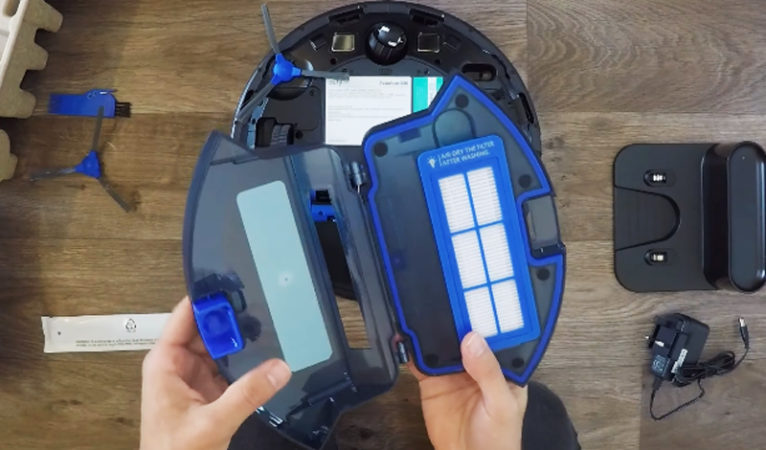When it comes to robotic vacuums, the Eufy G30 vs Roomba i3 are both highly regarded contenders, each offering their own commendable features. If you’re unsure about which one to choose, this article will provide guidance.
The Roomba i3 is a powerful and efficient cleaning device with adaptive cleaning patterns. It is also compatible with the clean-base automatic draw disposal, reducing the need for manual emptying of the bin.
The Eufy G30 is an affordable choice for your budget. This device is surprisingly powerful and works really well on hard floors and medium-pile carpets. It’s also designed to be quiet for those who are noise-sensitive.
Eufy G30 vs Roomba i3: Comparison Chart




Eufy G30 vs Roomba i3: Differences
After weighing the differences between these robot vacuums, I found that the Roomba i3 wins 3:1 and ties 1 against the Eufy G30 thanks to its cleaning performance and many other amazing features. Read the breakdown below to learn more specifics.
Cleaning Performance
The winner: Roomba i3
Compatible floor types
After testing both machines, I determined that they are most effective for cleaning hard floors and carpets with medium piles.
During my tests on hard floors, I observed that these machines can effortlessly collect medium-sized debris like rice, crumbs, and cereal. However, the Roomba i3 outperforms the Eufy in picking up larger particles like Froot Loops. The G30 may require multiple passes to completely clean up sand on hardwood floors, unlike the i3, which can do it in just one pass.
The Roomba i3 performs better than its opponent thanks to its two rubber brush rolls, which can handle all kinds of debris without damaging delicate surfaces. In contrast, the Eufy only has a bristle brush that is less effective.
In terms of carpet cleaning, the Roomba i3 is more effective than the Eufy G30. While both machines do a good job of cleaning surface dirt, the Roomba i3 is better equipped for deep cleaning. It has the ability to eliminate up to 85% of deeply embedded sand, whereas the Eufy G30 can only collect around 65% of sand from the carpet.

Pet hair performance
The Roomba i3 comes with a dual rubber brush roll system, which makes it more efficient at picking up pet hair. It is easier to untangle hair wrapped around a roller without any hassle.
The single bristle brush roll of the Eufy G30 is still okay for collecting pet hair, but it mainly ends up wrapped around the main brush. The bristle-stiff brushes tend to accumulate hair more quickly and tightly, as well as being harder to clear.
However, these robot vacuums can only handle a small amount of pet hair. If your home has pets that shed a lot, you may still need to use a traditional vacuum for this task.
Design & Usability
The winner: Eufy G30
Build quality
Both the Roomba i3 and Roomba 960 are designed to serve as reliable robotic vacuum cleaners.
The Roomba i3 is crafted for durability while prioritizing affordability. Its housing is made of high-quality plastic that may last for a long time. This machine is generally more straightforward, featuring fewer advanced sensors compared to the 960, which is evident in its construction. Additionally, the internal dustbin seems to be fragile.
As with the Roomba 960, the materials used feel more premium to the touch and are designed to last longer. It includes extra sensors and features, such as a camera for visual navigation. These components are securely housed in a more sophisticated frame.
Dimensions and weight
The Roomba i3 is approximately 13. inches in diameter and 3.63 inches in height, and weighing around 7.44 pounds, it is compact and maneuverable, allowing it to navigate around obstacles with ease and stability.
The Eufy RoboVac G30 is lighter and more compact than the i3, with dimensions of around 12.8 inches in diameter and 2.85 inches in height and a lighter weight of about 5.97 pounds. This size allows the device to excel in navigating spaces with lower clearance, like beneath sofas and beds, which are typically challenging areas.
In some instances, the G30’s low profile may cause problems. Although it can reach places that the Roomba i3 cannot, like under cabinets, it may become trapped and unable to escape. If this happens, you’ll need to step in and release it.
Battery and charging
Both devices utilize lithium-ion batteries, which are renowned for their ability to provide consistent power output. This ensures that the vacuum can maintain optimal performance throughout the cleaning cycle, resulting in a highly efficient run time. Moreover, the batteries have a relatively quick recharge time, which provides convenience and reliability.
| Roomba i3 | Eufy G30 | |
| Battery Life | Up to 75 minutes | Up to 100 minutes |
| Charge Time | 2 hours | 5-6 hours |
The Roomba i3 has a decent battery life, giving it the ability to operate for around 75 minutes before needing a recharge. This practical feature makes it a great option for cleaning small to medium-sized spaces continuously. Moreover, the i3 is equipped with a “Recharge and Resume” feature, allowing it to return to its dock and recharge automatically. Once it has regained enough power, it can continue cleaning from where it left off.
When it comes to the Eufy Robovac G30, the suction mode affects its runtime. In standard mode, the device can run for up to 100 minutes. Similar to the i3, the G30 can also automatically return to its docking station to recharge when its battery is low and then come back to complete the rest of the cleaning tasks.
About their recharge times, the Roakba i3 takes about 2 hours to fully charge, while the Eufy G30 requires 5–6 hours to recharge.
Noise
The Roomba i3 produces a noise level between 60 and 64 decibels, comparable to a normal conversation or television at moderate volume. My tests show that the device is quieter when it’s on low-pile carpets than on hardwood floors. It’s also quiet enough that it doesn’t scare the cat. My cat was just curious about it and followed it around.
The Eufy RoboVac G30 operates at a noise level of approximately 55 decibels, which is similar to a soft conversation or background music. This makes it an excellent choice for people who wish to avoid disruptions, especially during work or study hours at home. Additionally, it’s a perfect fit for individuals who are more sensitive to noise or for households with babies or pets that may be disturbed by louder sounds.
Navigation
These two robot vacuums have different navigation methods. The Roomba i3 is equipped with Irobot’s patented iAdapt technology, which incorporates multiple smart sensors, such as a floor tracking sensor, cliff sensors, and bumpers. This system allows the vacuum to navigate efficiently around furniture, avoid falls or accidents on stairs and other drop-offs, and keep track of its location to ensure complete cleaning coverage of your floors.
The Eufy Robovac G30 features Smart Dynamic Navigation 2.0 technology, which consists of a path-tracking sensor, allowing the machine to navigate in neat rows, detect obstacles, and ensure that no areas are missed.
Although both the G30 and i3 can clean in straight lines, my experience shows that the i3 is better at moving neatly and leaving less dirt on its path.
Control
The winner: Roomba i3
Both the Roomba i3 and the Eufy RoboVac G30 have user-friendly controls, but their control styles differ subtly.
The Roomba i3 provides users with several options for controlling it. You can use the iRobot Home App to schedule cleanings, monitor the cleaning process, and personalize cleaning preferences. In addition, it can be managed by voice commands using Google Assistant and Amazon Alexa, enabling you to easily start, stop, or dock the vacuum.

As for the Eufy G30, it offers control via the EufyHome app, allowing you to set cleaning schedules, manage the vacuum, and view cleaning sessions. Furthermore, the Eufy G30 can be controlled with Amazon Alexa and Google Assistant for voice control, similar to the Roomba i3. This feature makes it more convenient for users to operate the vacuum hands-free using voice commands. However, the Eufy G30 doesn’t offer the targeted cleaning room feature that the Roomba i3 does.
The Eufy G30 has a unique feature called “Boostiq ™ Technology,” which allows it to adjust its suction power automatically when moving from hard floors to carpets or encountering tougher debris. In contrast, the Roomba i3 only has one cleaning mode. However, in return, the i3 comes with Dirt Detect technology, which helps it detect dirtier areas and focus on cleaning them more thoroughly.
Cleaning & Maintenance
The winner: Roomba i3
Both the Eufy G30 and Roomba i3 come equipped with a dustbin, but the G30 has a slightly larger one, capable of holding up to 0.6 liters of dirt compared to the Roomba i3’s 0.5 liters. However, these numbers do not make a huge difference.
As for the Roomba i3, you can choose to upgrade your experience by replacing the original docking station with the Clean Base® Automatic Disposal. This accessory allows the device to self-empty and reduces manual intervention.
Once the dustbin is full, the device will automatically return to the docking station. The dirt inside the bin will be suctioned through the dirt disposal port and deposited into the dirtbag inside the docking station. The dirtbag has a capacity of approximately 2.65 liters and can last up to 60 days.

Both the Roomba i3 and Eufy G30 contain filters within their dustbins. The Roomba i3 boasts a high-efficiency filter, whereas the Eufy G30’s filter is decent but not as efficient as the Roomba i3’s.
Great For Value
Tie
While both the Roomba i3 and the Eufy RoboVac G30 offer strong performance and user-friendly features, the perceived value for price will largely depend on individual needs and preferences.
Generally, the Roomba i3 has a higher price point compared to Eufy’s G30, which might be a consideration for budget-conscious consumers. However, it offers better cleaning performance and many other convenient features, such as intelligent navigation, high-efficiency filtration, and compatibility with the Clean Base Automatic Dirt Disposal.
I consider the Eufy RoboVac G30 to be a better option for those looking to save money. Its Smart Dynamic Navigation 2.0 guarantees thorough and systematic cleaning while also including app and voice control capabilities. The vacuum operates quietly and has garnered praise for its cleaning efficiency, particularly on hard surfaces.
Quick Rundown Of Roomba i3
- POWERFUL CLEANING—SCHEDULED AROUND YOUR LIFE - Whether you’re relaxing at home or out enjoying life, Roomba i3 EVO takes care of dirt and messes with a Premium 3-Stage Cleaning System and 10x the Power-Lifting Suction*. *Compared to Roomba 600 series.Runtime : 75 minutes
- CLEAN BY ROOM, YOU’RE IN CONTROL - Roomba i3 EVO learns your home and creates an Imprint Smart Map so you can direct it to clean any room you want, any time you want—either on a set schedule or in the moment.
- CLEANING IN TIDY ROWS - Cleans intelligently in straight lines back and forth, to thoroughly clean your floors while navigating around furniture. When the i3 EVO needs to recharge, it will resume right where it left off ensuring a complete clean. Charger : 120V and 60 Hz
- FOCUSED CLEANING - Patented Dirt Detect Technology allows the Roomba i3 EVO to detect dirtier areas of your home and clean them more thoroughly. Integrated sensors tell the robot where it can and can’t fit, so it doesn’t get stuck under furniture.
- PERFECT FOR HOMES WITH PETS - Instead of using a single bristle brush, Roomba i3 EVO uses Dual Multi-Surface Rubber Brushes that flex to adjust to different floor types and avoid getting tangled with pet hair.
Quick Rundown Of Eufy G30
- [Dynamic Navigation] : With the Path Tracking Sensor, Dynamic Navigation 2.0 allows for purposeful cleaning across all surfaces when compared to random path robotic vacuums.
- [2000Pa of Hard-Hitting Suction] : The ultra-strong 2000Pa of suction power ensures more debris is picked up across all surfaces giving you noticeably cleaner floors.
- [App Control with Cleaning History] : Complete all your cleaning needs right from your smartphone. When the job is done check-out where and when your RoboVac cleaned.
- [BoostIQ Technology] : Automatically increases suction power within 1.5 seconds when extra vacuuming strength is needed—so you get the best clean.
- [Note]: Make sure you are using a 2.4GHz router or a dual-band router that is configured to support a 2.4GHz frequency band. RoboVac does not support 5GHz frequency band; The G30 model is not compatible with a self-empty station. If a self-empty station is an essential requirement for your cleaning preferences, we recommend opting for the G30+ model.
Product Videos
Related Articles to Roomba I3
- iRobot Roomba I3 Vs S9+: A Detailed iRobot Vacuum Comparison
- Roomba 692 vs i3: A Head-To-Head Comparison
- Roomba 671 Vs I3: Pros, Cons, and Performance
- Roborock Q5 vs Roomba I3: Clean Homes Powerhouse Face-Off!
- Roomba 981 Vs I3: How Do You Choose The Best Option For Your Home?
- Roomba 698 vs i3: Best Picks for Your Home!
- Roomba i3 vs j7: A Clash of Premium vs. Entry-Level Models
- Roomba i3 vs i7: Which Robot Vacuum Is Right For You?
- Roomba i3 vs i4: Which Affordable Entry-Level Roomba Is the Better Choice?
- Neato D8 vs Roomba i3: Which Robot Vacuum Is Right For You?
- Roomba i3 vs 960: Which iRobot Roomba Is The Most Affordable Option?
Related Articles to Eufy G30
- Eufy 11s Max vs G30: Which One Holds the Upper Hand?
- Eufy 11s vs G30: Which Is The Better Budget Robot Vacuum?
References:
- Roomba i3: https://www.irobot.com/en_US/roomba-i3-evo-robot-vacuum/I315020.html
- Eufy G30: https://us.eufy.com/products/t2250

Richard B. Schmidt is a prominent figure in the vacuum cleaner industry, boasting over 15 years of expertise. Armed with a Robotics Engineering degree from Northeastern University and a Master’s in Consumer Science from Harvard, his unique blend of technical knowledge and consumer insights positions him as a sought-after authority in vacuum cleaner evaluation. Richard’s career began at Dyson, where he contributed to the development of innovative vacuum models. Transitioning to advocacy and reviews, he co-founded the first Vacuum-focused blog in 2008, offering comprehensive analysis and user guides for various vacuum cleaners. In 2020, he founded RoboMop.net, providing ongoing insights through columns and buyer’s guides.
